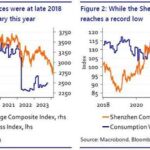

Traditionally, ATMs spit out cash to bank customers who insert their debit or credit card. But in a twist, a reverse concept — receiving a prepaid card from an ATM in exchange for cash — is rapidly growing in popularity.
Cash has been in decline for a while. In 2019, currency was used in 26% of consumer payments, a sharp decline from 40% in 2012, according to the Atlanta Fed. And the COVID-19 pandemic further encouraged a nationwide push away from physical currency, in part because of sanitary concerns and convenience.
DOLLAR PLUNGES 7.4% IN PAST SIX MONTHS — WHAT IT MEANS
The shift is fodder for the rise of the reverse ATM.
Jim Mohs, associate professor at the University of New Haven, told the Washington Examiner that the growth in popularity for this new breed of ATMs is relatively fresh. Still, he noted that despite only first learning about their existence recently, he has seen two of them while out and about in Connecticut over the past month or so. One was at a retail location, and the other was in a restaurant.
“Quite frankly, it’s a new phenomenon. Usually, the banks have the ATMs, you’re taking out of your account, or you’re taking money as an advance on a credit card or something, or you’re depositing checks, or you’re doing whatever your normal banking activities are,” Mohs said. But the reverse is now becoming a reality at retail stores and restaurants across the country.
With these new ATMs, users deposit the cash they have on them, which is then placed on plastic cards that they receive and can be used to spend. The idea comes as cash-only stores and merchants are quickly becoming replaced with cashless and card-only locales.
Reverse ATMs might be costly to purchase and maintain for businesses and venues such as hotels, casinos, amusement parks, and sports stadiums, where they are growing in popularity. Yet an increasing number of businesses are starting to see that the benefits outweigh the negatives, such as user fees at some of the machines.
Naushervan Beg, a partner and business development executive at Wavetec, which sells reverse ATMs, told Axios that reverse ATMs are becoming a competitive business space.
“Cash carries a lot of friction, right?” Beg said. “Many venues are willing to pay for the machines because, for them, the bigger pain point is taking the cash.”
One reason stores and restaurants may want to eschew cash is because of its potential to be a lightning rod for crime. Mohs said that it would make sense for businesses to want to switch to the cash-to-card model given the increases in crime that have been seen in cities since the outset of the COVID-19 pandemic. A store that doesn’t have thousands of dollars in cash lying around is less of a target.
Another basic desire to push away from cash is borne from basic convenience. Cash takes up space. When coins are added in, it becomes even more unwieldy. Having all of that cash condensed down into one or two cards can afford consumers much more convenience.
Another security reason why cards can trump cash is the ability to recoup stolen funds. If a thief pickpockets a customer’s wallet, for instance, that person has no means or recourse to get back their stolen funds (unless the perpetrator is apprehended). But if someone has their credit card swiped, it is possible to report their credit card as stolen to the bank and be off the hook for the missing money.
Retail crime more generally has been a major concern in recent years. Organized retail crime has dominated news reports, with videos emerging of groups of people ransacking retail stores and making off with large caches of stolen goods, often with the intent to resell.
The National Retail Federation released a report last year that found retail shrink, as taken as a percentage of total retail sales in 2021, added up to about $95 billion in losses that year. That is a 4% increase from 2020. Retailers themselves reported a 26.5% increase in crime on average, and a whopping 81% said that violence and aggression associated with it were up from the year prior.
“The factors contributing to retail shrink have multiplied in recent years, and [organized retail crime] is a burgeoning threat within the retail industry,” said Mark Mathews, vice president of research development and industry analysis at the NRF. “These highly sophisticated criminal rings jeopardize employee and customer safety and disrupt store operations. Retailers are bolstering security efforts to counteract these increasingly dangerous and aggressive criminal activities.”
Mohs said he expects that the cash-to-card ATMs will grow even more popular over the coming months and years. He also noted that the use of cash as a payment method is in retreat, which likely will continue, particularly if paper money and coins become less accepted by businesses.
“The economy is not as good as everyone makes it out to be,” Mohs said. “People are actually using a lot more credit to pay for their normal staples … I’ve got to believe within the next 10 or 15 years, cash is maybe not existent.”
CLICK HERE TO READ MORE FROM THE WASHINGTON EXAMINER
With the growing wave of reverse ATMs, it is conceivable that there may be some increased government scrutiny and oversight over their use.
When contacted specifically about the proliferation of reverse ATMs, a source at the Consumer Financial Protection Bureau told the Washington Examiner that the agency is aware of the growing use of the machines and other digital tools driven by and accelerated by the pandemic.





